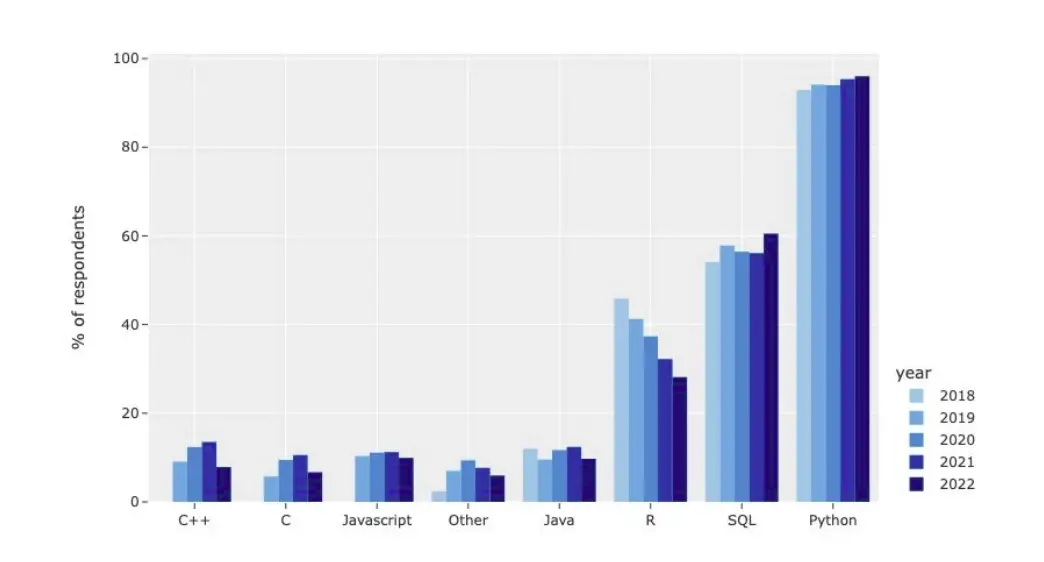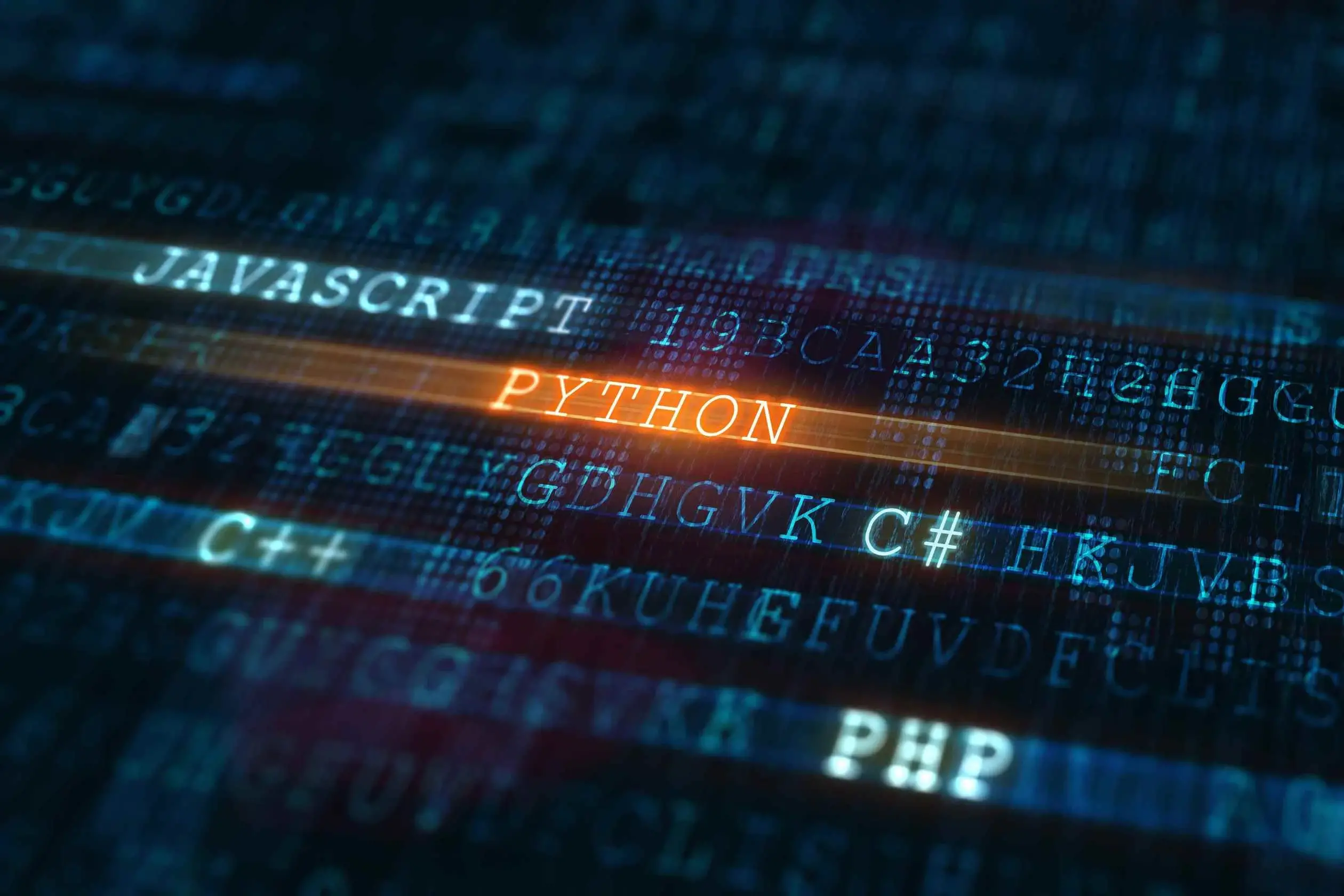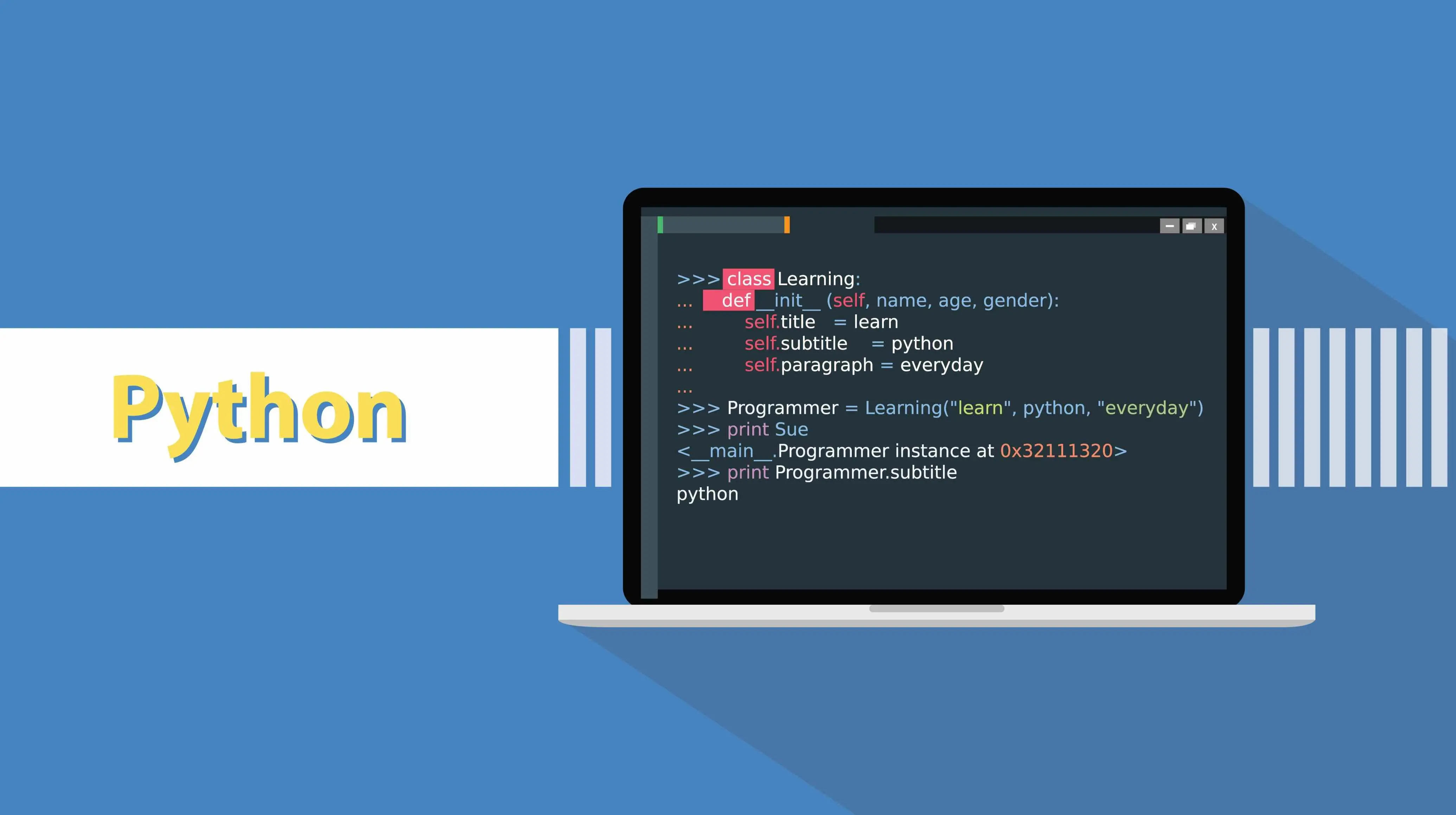The consensus is that Python is the preferred programming language for data scientists. Python is a programming language with a large community of users that keeps growing. So, for anyone looking for a career in the tech space through coding, Python is a great place to start.
Python is relatively easy to get into and incredibly versatile, and it is ubiquitous in different fields, from data science and machine learning to game design. As more organizations develop AI-based applications, it is critical to use a programming language that reduces code complexity and allows for easy implementation. Some innovations can quickly and efficiently increase a company's profit margins, while others boost productivity and the ability to make large business decisions.
With the current rise of big data, machine learning is among the technologies that can help translate massive information. But to accomplish this, you need to have a good programming language – like Python.
In a sense, the world of machine learning is programming. It has a variety of languages, just like any other world. In the programming world, developers have a plethora of languages, tools, and software at their disposal, making it difficult to know where to begin. Python is a great option if you are a developer who is looking to focus on the use of data and algorithms to imitate the way that humans learn. In this article, we'll go over what makes Python a great language for beginners and how it can be used for machine learning.
Python: What is it all about?
Python, a high-level programming language, was designed by Guido Van Rossum in 1991. The logic behind the creation and development of the Python programming language was to allow programmers to express their views in fewer lines of code and also create a language that is accessible to everyone. Amongst other reasons to consider Python compared to other programming languages, is the necessity of indentation in the code. Instead of using brackets, indentation is used to make the code more readable and understandable. Prioritizing indentation requires programmers to pay close attention to the script they are creating. Python, in addition to its simplicity, has several qualities, such as its extensive libraries, that make it ideal for integration. Aside from being a learning tool for new developers, the Python programming language has several other applications, including:
Data Science
According to Kaggle, an online community for data scientists, Python is the most-used programming language for data scientists. In addition to Python's extensive ecosystem, the language's ability to analyze large data sets very quickly and carry out repetitive tasks makes it in demand. Python is better suited for rapid prototyping, and its simplicity and ease of use make it simple for people with no engineering background to learn how to use.

App Development
Python is a fantastic option for anyone seeking to start developing applications. It is cross-platform, meaning it runs on multiple operating systems making it a universal language that can be used for web or mobile applications. Specifically, Python’s popularity is fast-growing in sectors of block chain app development and gaming app development thanks to its robust frameworks/tools (pyEthereum and pyBitcointools) and real-time testing which helps developers find and fix bugs quickly.
Web Development
Python is an adaptable programming language, making it effective for creating intricate web utilities. Particularly helpful are Python's various web frameworks, such as the well-known Django, which offer built-in functionality for server-side tasks like user authentication and authorization, managing databases, etc. to be completed more quickly and easily. Python is used by even big businesses to create websites; Google and YouTube both heavily rely on it for many of their digital infrastructures.
Because of its independent platform and widespread use in the programming community, Python is said to be the best programming language for “machine learning,” but what is machine learning?
Understanding Machine Learning

The term "machine learning" was coined by Arthur Samuel, a computer scientist and pioneer in artificial intelligence and computer gaming, in 1959. Machine learning is a branch of artificial intelligence (AI), and it is concerned with teaching computers to automatically solve problems and make decision with data. Simply put, machine learning is a technique that involves teaching computers or machines by feeding them numerous datasets so they can learn patterns and apply these patterns to new things. The data we feed machines allows them to make decisions. In machine learning, a model is built and data is fed to it. The machine is trained to detect patterns in the data and interpret, analyze, and process it using machine learning algorithms. Examples of machine learning applications are; self-driving cars, robotics, language and visual processing, games, weather detection, etc.
Types of Machine Learning
There are three main categories of machine learning, they are:
1. Supervised Machine Learning: This process of machine learning is carried out by using labeled data sets to train algorithms or data models to predict accurate outcomes.
2. Unsupervised Machine Learning: This process of learning involves training data, but the data is not labelled. The computer is fed enough data that’s not labelled so that it can find patterns that are not obvious to humans.
3. Reinforced Machine Learning: This process involves self-training, in other words, the machine learns on its own.
Benefits of Machine Learning
Here are some of the primary arguments in favor of using machine learning:
Automation
The main advantage of machine learning is how much time and resources it can save through automation. The machine can automate tasks without the need for human intervention, such as identifying patterns or making predictions, making the job of the developer more efficient.
Efficient Data Handling
Machine learning is able to analyze enormous amounts of data very quickly. Models are built to handle a large amount of data and also extract meaningful and insightful information effectively, especially in cases where the data is too large and complex for human comprehension. This efficient processing of data makes automation a must for businesses that focus heavily on data i.e. Accounting firms, banking and security firms, healthcare, route-calculating apps, etc.
Studying User Behavior
Algorithms are used in machine learning to find trends in data. User behavior is a great target for these algorithms. Using machine learning, you can learn a lot about user behavior on specific sites or applications. For example, online shopping sites can use visitor patterns to recommend similar products to their customers.
App Diversity
Machine learning is applicable to many projects. Almost everything benefits from using machine learning in some way. Sectors like education, healthcare, banking, technology, and science greatly benefit from the efficiency brought by machine learning. Machine learning allows for faster detection, data analysis, and the general speeding up of any software-related process; its models are also able to adapt to change as technology advances, leading to advanced innovations.
Creating a Machine Learning Project
There are different steps to follow when creating a machine learning project; these steps usually vary depending on the problem, data, and algorithm. However, a typical step would involve;
- Problem definition
- Collection of data
- Clearing data
- Data visualization
- Dividing data into sets (Training and Testing)
- Create a model - Choosing an algorithm to work with
- Model Training
- Model evaluation and improvement
- Model Deployment
Why do developers prefer using Python for Machine Learning?
In recent years, Python has become the go-to programming language for machine-learning applications. It stands out for its readability, ease of use, and accessibility, even to programming newbies. It’s also portable because it runs on all operating systems, including Windows, MacOS, Linux, etc., without any need for modification. Overall, Python's strong point as the machine-learning language of choice is its vast ecosystem. Most machine-learning algorithms are implemented directly in Python using its libraries and tools. What's more, the community actively provides support for its members, which means that for virtually any problem you're likely to encounter in the beginning, you can find a solution online.
What Can You Do with Python in the Area of Machine Learning?
Python can be used for several tasks in the machine learning field, like data analysis, machine learning model visualizations, training and evaluating machine learning models, the use of machine learning algorithms for image and speech recognition, computer vision, etc. Python for machine learning is also used to personalize and improve user experiences; for example, machine learning can automate customer service, detect fraudulent transactions, recommend products, enhance search engine results, automate translation, detect fraud, recommend music, and forecast medicine treatment success. Because of its many applications in using and managing data, data scientists must have extensive knowledge of Python programming and its uses. The use of machine learning is in high demand, and this is expected to increase in the coming years.
Python vs. other languages

In the 2021 survey by JetBrains, 85% of developers used Python as their primary language, while the remaining 15% used it as a secondary language. More than 23,000 Python developers participated in this Python Developers Survey. The most common language that developers pair with Python is discovered to be JavaScript. The survey also showed that more than 50% of developers preferred Python for data science.
Java
Java is a more verbose and difficult-to-learn programming language when compared to Python. Java uses static typing in contrast to Python, which makes development a little more difficult. In comparison to Python, it has fewer machine-learning library options. Although Java is considered to be faster than Python during runtime, developing a Python program takes less time due to fewer lines of code. Python codes are also usually 3-5 times shorter as compared to Java. This difference is significant because Python programmers spend less time declaring types of arguments or variables.
JavaScript
JavaScript can be used for machine learning; however, unlike web development, where it is a great option, it is rather constrained for complex and large-scale projects. Additionally, Python is far more flexible than JavaScript; it can be used for a variety of tasks like web development, machine learning, data analysis, scientific computing, and more.
C++
C++ is considered harder to learn and work with, while Python is known for its readable and easy-to-learn syntax. Python's code is 5-10 times shorter than that of C++; for instance, C++ is a statically typed language, which means that the type of a variable must be specified at the time of declaration and cannot be changed during the execution of the program, while Python is dynamically typed, meaning the type of a variable may not be specified at the time of declaration.
The vast number of advantages Python offers have made it one of the most popular programming languages for building large-scale AI-based applications.
What is the learning curve for Python for machine learning?
There’s no specific time set to learn Python for machine learning because different factors determine how long it’ll take anyone to learn, depending on the individual's capacity and dedication. However, you must understand Python programming basics before dedicating time to building machine learning projects. It’s also important to realize that it’ll take a long time and that learning is a continuous process.
Python Libraries and Frameworks, how do they support Python machine learning?

The Python library and frameworks provide built-in functions, algorithms, and tools to implement machine learning models without starting from scratch. Some examples of these libraries/frameworks include;
Tensor Flow
This is an open-source library that can be used for multiple tasks, including deep learning, neural networks, and computer vision.
Scikit-Learn
This is a library that provides algorithms for tasks such as regression, classification, dimensionality reduction, etc.
PyTorch
This is an open-source library, or what can be referred to as a "computing package," that is used to develop and train learning models based on a neural network.
Keras
This is a neural-network library that runs on TensorFlow and provides a simplified interface for building and training machine-learning models.
Django
This is a framework that provides tools that support machine learning projects. e.g., ORM (Object-Relational Mapper), which allows you to interact with your database.
Pyramid
This is a framework that consists of tools for integrating with machine learning libraries.
These libraries/frameworks are important for implementing, training, and deploying machine learning models in Python, and their use will become clearer once you begin to interact with them while working on machine learning projects.
Summary
Overall, choosing Python as the preferred language for machine language is based on the benefits it proposes. Python is considered to be easy to read and consume, and its high performance makes it a great choice for performing complex computations and also analyzing data sets efficiently. Python's ecosystem is very large, with frameworks and tools like Tensorflow, PyTorch, Scikit-learn, etc. These tools are responsible for several tasks, such as data processing, model training, evaluation, etc., for developing complex models.
The demand for machine learning spans across industries; healthcare, transportation, retail, finance, and the list goes on. Companies and organizations are heavily investing in hiring professionals with the right skills to meet their users' needs and stay on top of their game. Machine learning with the aid of the Python programming language would equip you with the necessary knowledge to excel in the field, especially if you enjoy solving complex problems or creating solutions that’ll impact society positively.
And no matter what you pursue, just know you can always trust Python Hosting offered by Verpex. Our secure, reliable, and optimized servers provide an ideal environment for your applications and websites.
Frequently Asked Questions
Why should I create a website?
There are many reasons why you should create a website if you’re an artist. You can use it to create a place where people can learn about you, talk about your art, or show off your work.
How is the website maintenance carried out?
On a daily basis, software, hardware, vulnerability, MariaDB, CloudLinux paths and cPanel updates are carried out on our servers without a reboot. However, if we have to carry out any maintenance that includes some downtime, we schedule in advance and update our status page
How do I choose a design for my website?
One of the most important things when creating a website for your art is the design. Even though your pieces of art might be amazing, people will leave if your site is hard to navigate. This is why it’s important that the site is easy on the eyes and easy to navigate.
What is the best way to display my art on my website?
Your website can be used for many things; however, you need to keep in mind that you created your website to promote your art. Don’t get wrapped up in all the things around your site and forget to put the primary focus on your art.

Jessica Agorye is a developer based in Lagos, Nigeria. A witty creative with a love for life, she is dedicated to sharing insights and inspiring others through her writing. With over 5 years of writing experience, she believes that content is king.
View all posts by Jessica Agorye





















